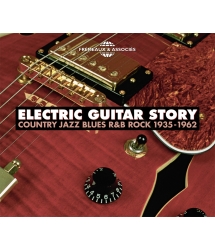One of the easiest ways to demonstrate the scope of this three CD set is to pick at random five or six of the artists to be found consecutively in the track-listing : for example, T-Bone Walker, Les Paul, Louis Jordan, Bob Wills, George Barnes, and Arthur Crudup from the first CD covering the years 1935 to 1949, maybe Hank Garland, Sol Hoopii, Chet Atkins, Otis Blackwell, B.B. King and the duo of Speedy West and Jimmy Bryant from disc two (1948-1955) or Lonnie Brooks, Dale Hawkins, Theophilus Beckford, Link Wray, Chuck Berry and Buddy Guy from the third CD (1954-1962). Some of you might have noticed that several of those names are not known as guitarists, but the electric guitar plays a significant role in all the 72 tracks of this collection. The tracks are in rough chronological order.
Stylistically, the music stretches across western swing, blues, jazz from big band to free, Hawaiian, gospel, rock’n’roll, Jamacain r&b blues and early sixties rock instrumental, all united in their use of the instrument under consideration. Although a compilation like this will always be subjective, there can be no quibble with the inclusion of such blues guitarists Pete “Guitar” Lewis, Guitar Slim, Pee Wee Crayton, Mickey Baker, Albert King, Albert Collins and Johnny “Guitar” Watson (“Space Guitar” of course for the latter), though I looked in vain for one of Freddy King’s rousing and influential instrumentals or nowadays massively influential Magic Sam. A more down-home sound comes courtesy of Muddy Water, pat Hare , Elmore Jams, John Lee Hooker and Lightnin’ Hopkins, who precedes Lennie Tristano’s almost free jazz number (with Billy Bauer on guitar, in case you were wondering). The gospel tradition has just one inclusion, Sister Rosetta’s “This Train”, and jazz guitarists include Charlie Christian, Eddie Durham, Jimmy Shirley, Billy Butler and Barney Kessel, who should all be familiar names to most readers. Ace country pickers Chet Atkins and Merle Travis are both present and correct, Chuck, Bo, Elvis, Buddy Holly, Bill Haley and Gene Vincent represent good old rock’n’roll, The Ventures and The Shadows the sound of rock instrumental, and whilst Link Wray’s “Rumble” is often cited as the originator of the power chording that was to become popular at the end of the 60s, Johnny Winter’s “School Day Blues”, recorded for Dart in 1959 as by Johnny & The Jammers is, due to the time-span of the set, the only track by any of those while musicians who were to rework the blues in the following decade. The vast majority of the performers throughout the set are American, though there is also room for Django Reinhardt , the aforementioned Jamaican Theophilus Beckford, UK outfit The Shadows, and the Budapest born Elek Bacsik. The notes trace the history of the instrument and also help to explain the preponderance of western swing tracks among the earliest numbers good to note that the Floyd Smith/Andy Kirk number, “Floyd’s Guitar Blues”, one of the earliest hit records to feature an electric guitar, is actually track nine on the first CD, which shows the amount of research that has gone into this excellent collection.
Par Norman DARWEN - BLUES & RHYTHM
Stylistically, the music stretches across western swing, blues, jazz from big band to free, Hawaiian, gospel, rock’n’roll, Jamacain r&b blues and early sixties rock instrumental, all united in their use of the instrument under consideration. Although a compilation like this will always be subjective, there can be no quibble with the inclusion of such blues guitarists Pete “Guitar” Lewis, Guitar Slim, Pee Wee Crayton, Mickey Baker, Albert King, Albert Collins and Johnny “Guitar” Watson (“Space Guitar” of course for the latter), though I looked in vain for one of Freddy King’s rousing and influential instrumentals or nowadays massively influential Magic Sam. A more down-home sound comes courtesy of Muddy Water, pat Hare , Elmore Jams, John Lee Hooker and Lightnin’ Hopkins, who precedes Lennie Tristano’s almost free jazz number (with Billy Bauer on guitar, in case you were wondering). The gospel tradition has just one inclusion, Sister Rosetta’s “This Train”, and jazz guitarists include Charlie Christian, Eddie Durham, Jimmy Shirley, Billy Butler and Barney Kessel, who should all be familiar names to most readers. Ace country pickers Chet Atkins and Merle Travis are both present and correct, Chuck, Bo, Elvis, Buddy Holly, Bill Haley and Gene Vincent represent good old rock’n’roll, The Ventures and The Shadows the sound of rock instrumental, and whilst Link Wray’s “Rumble” is often cited as the originator of the power chording that was to become popular at the end of the 60s, Johnny Winter’s “School Day Blues”, recorded for Dart in 1959 as by Johnny & The Jammers is, due to the time-span of the set, the only track by any of those while musicians who were to rework the blues in the following decade. The vast majority of the performers throughout the set are American, though there is also room for Django Reinhardt , the aforementioned Jamaican Theophilus Beckford, UK outfit The Shadows, and the Budapest born Elek Bacsik. The notes trace the history of the instrument and also help to explain the preponderance of western swing tracks among the earliest numbers good to note that the Floyd Smith/Andy Kirk number, “Floyd’s Guitar Blues”, one of the earliest hit records to feature an electric guitar, is actually track nine on the first CD, which shows the amount of research that has gone into this excellent collection.
Par Norman DARWEN - BLUES & RHYTHM











